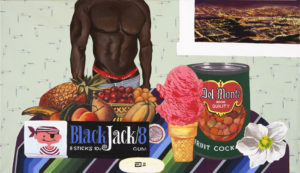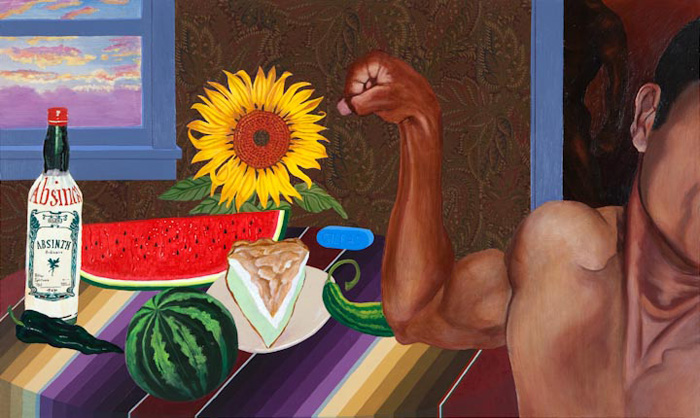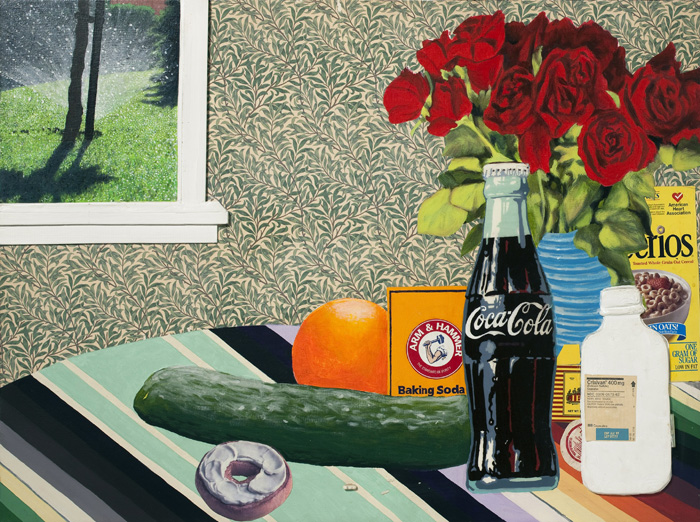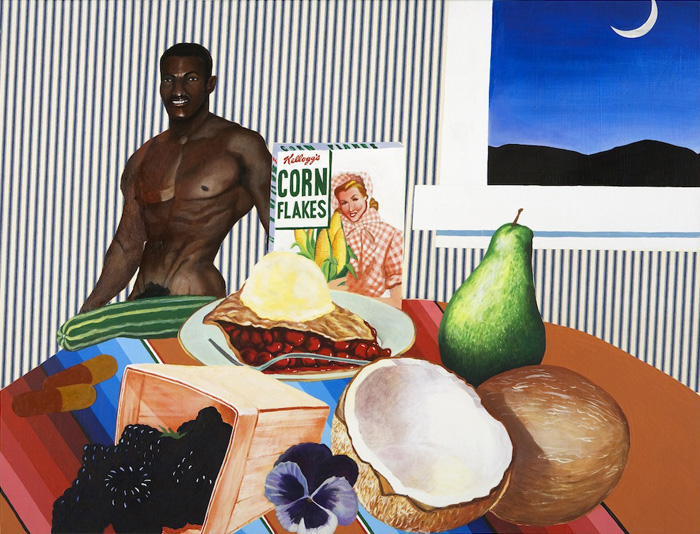
Joey Terrill: Still Life Series
Black Jack, 2008
About the artist:
Joey Terrill is a second-generation native Angeleno, who has been painting and making art for over 30 years. Born in 1955, his work combines influences ranging from his love of pop art to Mexican retablos and 20th century painters ranging from Romaine Brooks to Frida Kahlo as well as the energy, politics and creative synergy of Chicano and queer art circles in Los Angeles.
He attended Immaculate Heart College from 1973 to 1976 when conceptual art ruled and the feminist strategy of the personal being political was in full flower.
“The sources and images for most of my work have been autobiographical, whether painting, collage, silkscreen or drawing. Friends, family, lovers and self-portraits are the visual sources for the pictures I paint.”

A Bigger Piece, 2008
I’ve been drawing since the age of three and from the very start of this endeavor I tended to draw “pictures” of people I saw on TV or in magazines (albeit not very well). Drawing as an artistic exercise has evolved over the years veering into one direction or another with sometimes a focus on still-life arrangements while at other times human models. The last few years has my drawings combining elements from both methods…faces, body parts, and genitalia with pieces of fruit or vegetables or sometimes inanimate objects like bones, dishes or HIV medications. My drawings differ from my paintings in as much as they are observed studies from life, while the paintings I do are pictures taken from photographic sources.

Still Life With Crixivan, 1997-1998
About The Still-Life Series
The “Still-Life” series came out of a desire to make art about my ambivalent feelings regarding living in this era of the HIV cocktail and the industry that has flourished around the disease.
Twenty years ago, art that dealt with AIDS was about the governmental inaction, homophobia, AIDSphobia, and the wave of death decimating the artist population. Art tended to be political, angry (righteously so) and emotional. Explorations of the body, commemorative odes to fallen comrades and/or agit-prop of tremendous power, Collectively the body of work from that era has become a memento mori- i.e. – a reminder of death, human mortality and political failure.
My desire was to make art that reflected my observation as a long-term survivor, of the place where HIV has landed in the U.S marketplace and popular culture two decades after it’s discovery. I chose to use the formal language of Pop Art, taking my cue from Warhol, Hockney, Ruscha but especially Wesselmann who’s still- lifes from the late 50’s –early 60’s made from collaged “found” advertising and materials were ironic illustrations of American consumerism and sexuality. The skewed perspective resulting from placing illustrations of products from different advertising sources next to one another on a table top imbued his pieces with a hyper-reality and humor that felt like an accurate method of evoking the skewed perspective of long term survivors at the beginning of the 21st century. On the one hand we have the psychological (and physical) reality of being alive while most of our friends are dead, coupled with the bombardment of pharmaceutical advertising portraying a healthy, athletic, even sexually vibrant way of life with full page imagery of men climbing mountains, looking at sunrises, holding hands and smiling with fulfillment. The marketing of pharmaceuticals, (with HIV drugs as a subset niche market) has become an accepted part of American life with ads in media outlets from radio and television to billboards and magazines bombarding us with a range of pills, capsules and tablets.
Underneath these pictures of health and vigor one finds the fine print detailing the harsh realities of potential side effects, with a range of human misery from fevers, rashes, diarrhea, vomiting, onset of diabetes, and heart failure to “in some cases”… death.

Life with Zerit, 2000
The possibility of severe side effects is most evident with people who by their diagnosis already have suppressed immune systems, which in turn are clobbered by toxic remedies that may or may not work. It’s a rather schizophrenic perspective on the pursuit of happiness. Yes, we are glad to be still alive, but the journey is filled with side detours, side effects and in fact I have had friends die from complications arising from long-term use of HIV medications.

The Sweeter the Juice, 2003
Lest you think I’m “anti-HIV drugs” let me state that I am not. I recognize the tremendous work and dedication of doctor’s, scientist’s and political activists (myself included) whose efforts have led in one way or another to the varied options for combating this “smart” evolving, mutating virus that used to be an automatic death sentence. But the marketing and billions of dollars in profit made by the drugs manufacturers puts these “life-saving” medications in the same category as any consumer product in American culture. In the Still-Life series product placement puts Viracept, Zerit, Videx …et.al. next to Peter Pan peanut-butter, Arm & Hammer Baking Soda and Coca-Cola.
